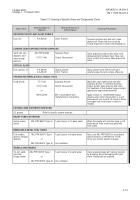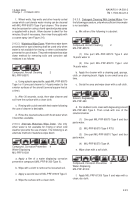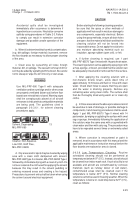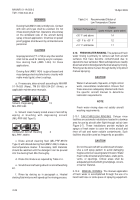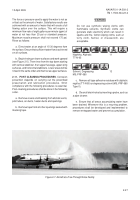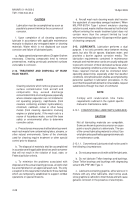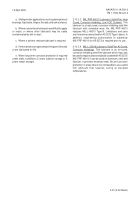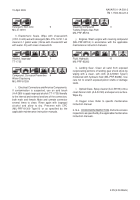TM-1-1500-344-23-2 - Page 53 of 240
2-29
NAVAIR 01-1A-509-2
TM 1-1500-344-23-2
15 April 2009
CAUTION
The use of the correct lubricating material is
critical. Use only lubricants specified by the
applicable manual or maintenance card.
2-13.1.2. Table 2-5 contains the title, specification,
intended use, and temperature range of the most
frequently used conventional lubricating materials.
2-13.2. APPLICATION
OF
CONVENTIONAL
LUBRICANTS. The proper method of application is
important. Apply lubricant as specified in the appropriate
maintenance manual. Lubricants can be applied by one
of the following methods:
a. Grease guns: lever or pressure type;
b. Oil, squirt, and aerosol spray cans; or
c. Hand or brush.
2-13.2.1. When lubricating hinges and pinned joints,
apply MIL-PRF-81309 Type II or MIL-PRF-63460 before
applying lubricant.
2-13.2.2. Always apply generous quantities of lubricant,
and actuate the joint several times to make sure that the
lubricant penetrates all crevices thoroughly.
CAUTION
Excess lubricant can attract dust, dirt, and other
foreign material during aircraft service.
2-13.2.3. Wipe away any excess lubricant.
2-13.2.4. Grease Gun Application.
2-13.2.4.1.
When applying lubricants through pressure
type fittings with a grease gun, clean grease fitting with
degreasing solvent (MIL-PRF-680) and a clean cloth
before applying lubricant.
2-13.2.4.2. Be certain the grease gun is properly
attached to the fitting prior to applying pressure.
2-13.2.4.3.
Make sure the lubricant has emerged
around the bushing. If no grease appears, check the
fitting and grease gun for proper operation.
2-13.2.4.4. When applying grease to a flush type (high
pressure) fitting, make sure that the grease gun is fitted
with a flush type adapter and held perpendicular to the
surface of the fitting before applying pressure. If the
fitting does not accept lubrication, replace the fitting and
lubricate.
2-13.2.4.5. Wipe excess grease from fitting with a
clean, dry cloth.
2-13.3. SOLID FILM LUBRICANTS. These lubricants
prevent galvanic coupling on close tolerance fittings
and reduce fretting. Solid film lubricants are used where
conventional lubricants are difficult to apply or retain, or
where other lubricants may be contaminated with dust,
wear products or moisture. Typical applications of solid
film lubricants are sliding motion components such as
flap tracks, hinges, turnbuckles and cargo latches. Solid
film lubricants shall not be used in the following
circumstances:
a. Do not use solid film lubricants in areas subject to
rotational speeds above 100 rpm under heavy loads.
b. Do not use solid film lubricants on roller bearing
elements.
c. Do not use solid film lubricants in conjunction with
oils or greases.
d. Do not use where there is a potential contact with
liquid oxygen.
2-13.3.1. Surface cleanliness and preparation is
extremely important to the service wear life of solid film
lubricants. They may be applied over bare metal
surfaces, or over surfaces that have been pre-coated
with other films, such as anodized aluminum and
phosphated steel. They have also been successfully
applied over organic coatings such as epoxy primers.
2-13.3.2. SAE AS 5272 (Lubricant, Solid Film, Heat
Cured, Corrosion Inhibiting). This lubricant is a heat
cured, corrosion-inhibiting solid film lubricant with
extended wear life. AS 5272 Type I and Type II replaces
MIL-L-46010 Type I and Type II. It can be used on
aluminum, copper, steel, stainless steel, and titanium.
AS 5272 Type II must be cured at 400
°
F (204
°
C) for
one hour. If metallurgical damage is done at this
temperature, AS 5272 Type I, which cures at 300
°
F
(149
°
C) for one hour, must be used. Due to the
temperature requirements, this lubricant is not
suitable for all applications. AS 5272 is recommended
for use under the following conditions:
Back to Top

